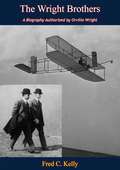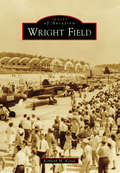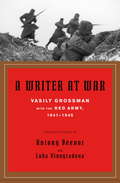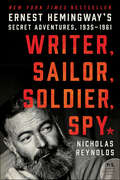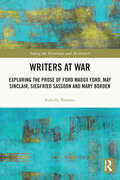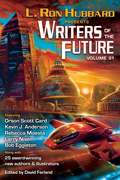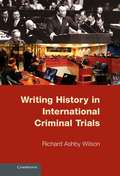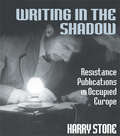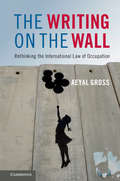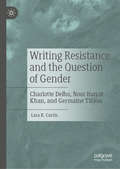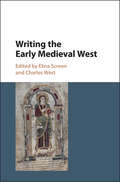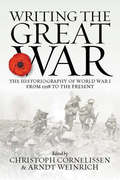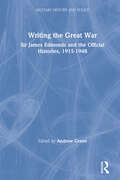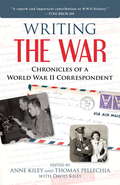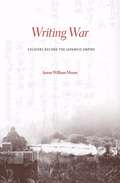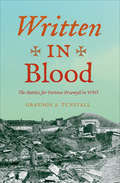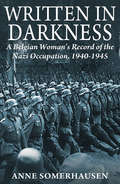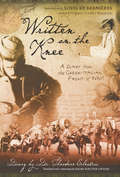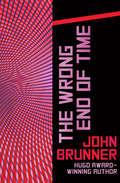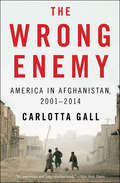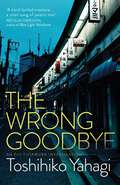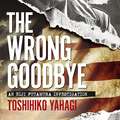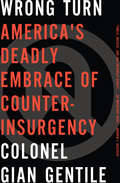- Table View
- List View
The Wright Brothers: A Biography Authorized by Orville Wright (Dover Transportation Ser.)
by Fred C. KellyOn December 17, 1903, in a fragile little plane which they had built at home for less than $1,000, Wilbur and Orville Wright made the first powered flights in the history of mankind—and opened the Air Age.Why did these two brothers, mechanics by trade, succeed where trained scientists—working with unlimited funds and the backing of great institutions—had repeatedly failed?In this biography, authorized by Orville Wright and first published in 1943, Fred Kelly separates fact from legend and recreates the dramatic achievements of two men, self-taught inventors, who solved the “impossible” problem of flight.The Wright Brothers is a story of total adventure—the sharp physical adventure of flight in perilously frail machines, and the breathtaking intellectual adventure of minds discovering through tireless research and sudden, brilliant hunches the solution to the “impossible” problem of flight.Fred Kelly is recognized as one of the world’s foremost authorities on the Wright brothers—their growth, their struggles, their disappointments and their ultimate triumph. For more than thirty years he was a personal friend of Orville Wright and talked with him daily while writing this book. The result is a vivid recreation of the birth and pioneer days of aviation and an intimate, affectionate portrait of two men whose inventive genius changed the world.“A gripping book on a fascinating subject...”—Boston Globe
Wright Field: The Wright Brothers To Mccook Field (Images of Aviation)
by Kenneth M. KeiselFrom its founding in 1927 until the establishment of Wright-Patterson Air Force Base in 1948, Wright Field played a vital role keeping the Army Air Force positioned as the world's leader in aircraft design and development. The Second World War catapulted it into the forefront of America's war effort, as virtually every new aircraft produced for the Army Air Force was developed and tested in Dayton. Wright Field's testing program also had the fascinating task of studying captured enemy aircraft, including some powered by jet engines, which engineers at the installation were also developing. Images of Aviation: Wright Field features scores of amazing photographs that tell the story of the airfield from its founding in 1927 through World War II, the Cold War, and beyond. Readers will also see the impact the base has played in the local community by providing thousands of jobs, as well as some of the greatest air shows ever held in the United States. Finally, a collection of crash photographs reveals the often tragic consequences that inevitably come with the testing of advanced experimental aircraft.
A Writer at War
by Vasily GrossmanVasily Grossman's masterpiece LIFE AND FATE is rated by many as the greatest Russian novel of the twentieth century. Among its admirers is Antony Beevor, the bestselling author of Stalingrad and Berlin. A WRITER AT WAR is based on the notebooks in which Grossman gathered his raw material. It depicts as never before the crushing conditions on the Eastern Front and the lives and deaths of infantrymen, tank drivers, pilots, snipers and civilians alike. Deemed unfit for service when the Germans invaded in 1941, Grossman became a special correspondent for Red Star, the Red Army newspaper. Remarkably, he spent three of the following four years at the front observing with a writer's eye the most pitiless fighting ever known. Grossman witnessed almost all the major events on the Eastern Front: the appalling defeats and desperate retreats of 1941, the defence of Moscow and fighting in the Ukraine. In August 1942 he was posted to Stalingrad where he remained during four months of brutal street-fighting. He was present at the battle of Kursk, the largest tank engagement in history, and, as the Red Army advanced, he reached Berdichev where his worst fears for his mother and other relations were confirmed. A Jew himself, he undertook the faithful recording of Holocaust atrocities as their extent dawned. His supremely powerful report 'The Hell of Treblinka' was used in evidence at the Nuremberg tribunal. A WRITER AT WAR offers the one outstanding eye-witness account of the war on the Eastern Front and perhaps the best descriptions ever of what Grossman called 'the ruthless truth of war'.
Writer, Sailor, Soldier, Spy: Ernest Hemingway's Secret Adventures, 1935–1961
by Nicholas E. ReynoldsThe extraordinary untold story of Ernest Hemingway's dangerous secret life in espionageA NEW YORK TIMES BESTSELLER • A finalist for the William E. Colby Military Writers' Award"IMPORTANT" (Wall Street Journal) • "FASCINATING" (New York Review of Books) • "CAPTIVATING" (Missourian)A riveting international cloak-and-dagger epic ranging from the Spanish Civil War to the liberation of Western Europe, wartime China, the Red Scare of Cold War America, and the Cuban Revolution, Writer, Sailor, Soldier, Spy reveals for the first time Ernest Hemingway’s secret adventures in espionage and intelligence during the 1930s and 1940s (including his role as a Soviet agent code-named "Argo"), a hidden chapter that fueled both his art and his undoing. While he was the historian at the esteemed CIA Museum, Nicholas Reynolds, a longtime American intelligence officer, former U.S. Marine colonel, and Oxford-trained historian, began to uncover clues suggesting Nobel Prize-winning novelist Ernest Hemingway was deeply involved in mid-twentieth-century spycraft -- a mysterious and shocking relationship that was far more complex, sustained, and fraught with risks than has ever been previously supposed. Now Reynolds's meticulously researched and captivating narrative "looks among the shadows and finds a Hemingway not seen before" (London Review of Books), revealing for the first time the whole story of this hidden side of Hemingway's life: his troubling recruitment by Soviet spies to work with the NKVD, the forerunner to the KGB, followed in short order by a complex set of secret relationships with American agencies.Starting with Hemingway's sympathy to antifascist forces during the 1930s, Reynolds illuminates Hemingway's immersion in the life-and-death world of the revolutionary left, from his passionate commitment to the Spanish Republic; his successful pursuit by Soviet NKVD agents, who valued Hemingway's influence, access, and mobility; his wartime meeting in East Asia with communist leader Chou En-Lai, the future premier of the People's Republic of China; and finally to his undercover involvement with Cuban rebels in the late 1950s and his sympathy for Fidel Castro. Reynolds equally explores Hemingway's participation in various roles as an agent for the United States government, including hunting Nazi submarines with ONI-supplied munitions in the Caribbean on his boat, Pilar; his command of an informant ring in Cuba called the "Crook Factory" that reported to the American embassy in Havana; and his on-the-ground role in Europe, where he helped OSS gain key tactical intelligence for the liberation of Paris and fought alongside the U.S. infantry in the bloody endgame of World War II.As he examines the links between Hemingway's work as an operative and as an author, Reynolds reveals how Hemingway's secret adventures influenced his literary output and contributed to the writer's block and mental decline (including paranoia) that plagued him during the postwar years -- a period marked by the Red Scare and McCarthy hearings. Reynolds also illuminates how those same experiences played a role in some of Hemingway's greatest works, including For Whom the Bell Tolls and The Old Man and the Sea, while also adding to the burden that he carried at the end of his life and perhaps contributing to his suicide.A literary biography with the soul of an espionage thriller, Writer, Sailor, Soldier, Spy is an essential contribution to our understanding of the life, work, and fate of one of America's most legendary authors.
Writers at War: Exploring the Prose of Ford Madox Ford, May Sinclair, Siegfried Sassoon and Mary Borden (Among the Victorians and Modernists)
by Isabelle BrasmeWriters at War addresses the most immediate representations of the First World War in the prose of Ford Madox Ford, May Sinclair, Siegfried Sassoon and Mary Borden; it interrogates the various ways in which these writers contended with conveying their war experience from the temporal and spatial proximity of the warzone and investigates the multifarious impact of the war on the (re)development of their aesthetics. It also interrogates to what extent these texts aligned with or challenged existing social, cultural, philosophical, and aesthetic norms. While this book is concerned with literary technique, the rich scholarship on questions of gender, trauma, and cultural studies on WWI literature serves as a foundation. This book does not oppose these perspectives but offers a complementary approach based on close critical reading. The distinctiveness of this study stems from its focus on the question of representation and form and on the specific role of the war in the four authors’ literary careers. This is the first scholarly work concerned exclusively with theorising writing produced from the immediacy of the war. This book is intended for academics, researchers, PhD candidates, postgraduates and anyone interested in war literature.
Writers of the Future Volume 31
by Tim Napper Martin L. Shoemaker Amit Dutta Choong Nyung Yoon Krystal Claxton Quinlan Septer Samantha Murray Taylor Payton Emily Siu Tung Chi Lee Alex Brock Sharon Joss Daniel J. Davis Larry Niven David Farland Michelle Lockamy Amy H. Hughes Kary English Daniel Tyka Zach Chapman Kevin A. Anderson Megen Nelson Scott R. Parkin Orson Scott Card L. Ron Hubbard Michael T. Banker Rebecca Moesta Auston Habershaw Megan Kelchner Shuangjian Liu Steve PantazisThe future is here...the future is now! Orson Scott Card, Kevin J. Anderson and Larry Niven have seen the future. Now, you can, too. A constellation of the brightest lights in the Science Fiction and Fantasy firmament have judged these authors to be the best, the brightest, the truest emerging stars in the field. From Alien Invasion to Alternate History, from Cyberpunk to Comic Fantasy to Post-Apocalyptic Worlds, these are the winning writers who have mastered every version and vision of sci-fi and fantasy. Don't be left behind. Get a read on what's next."The Writers of the Future contest looks for people with the best imaginations who can see through the possibilities of the strangest and best ideas and tell stories that intrigue us and involve us." --ORSON SCOTT CARD Celebrate the 31st anniversary of the Writers of the Future contest and the 26th anniversary of the Illustrators of the Future contest #WofF31
Writing History in International Criminal Trials
by Richard Ashby WilsonWhy do international criminal tribunals write histories of the origins and causes of armed conflicts? Richard Ashby Wilson conducted research with judges, prosecutors, defense attorneys and expert witnesses in three international criminal tribunals to understand how law and history are combined in the courtroom. Historical testimony is now an integral part of international trials, with prosecutors and defense teams using background testimony to pursue decidedly legal objectives. In the Slobodan Milošević trial, the prosecution sought to demonstrate special intent to commit genocide by reference to a long-standing animus, nurtured within a nationalist mindset. For their part, the defense called historical witnesses to undermine charges of superior responsibility, and to mitigate the sentence by representing crimes as reprisals. Although legal ways of knowing are distinct from those of history, the two are effectively combined in international trials in a way that challenges us to rethink the relationship between law and history.
Writing in the Shadow: Resistance Publications in Occupied Europe
by Harry StoneThe first complete national and international survey in the English language of the clandestine newspapers and books published in the occupied countries of Europe during the Second World War.A man with earphones crouching in the attic listening in with a crystal set, a prisoner writing fearfully even in the condemned cell, youths taking courses in weightlifting so as to be able to carry cases of lead type with apparent ease: these are just some of the people who helped produce clandestine newspapers and books in the occupied countries of Europe during the Second World War. Writing in the Shadow describes the risks these people ran and the ingenuity and brilliant improvisation they used to hoodwink the Nazis and distribute newsletters to tens of thousands of people.
The Writing on the Wall
by Aeyal GrossAs Israel's control of the Occupied Palestinian Territory nears its fiftieth anniversary, The Writing on the Wall offers a critical perspective on the international law of occupation. Advocating a normative and functional approach to occupation and to the question of when it exists, it analyzes the application of humanitarian and human rights law, pointing to the risk of using the law of occupation in its current version to legitimize new variations of conquest and colonialism. The book points to the need for reconsidering the law of occupation in light of changing forms of control, such as those evident in Gaza. Although the Israeli occupation is a main focal point, the book broadens its compass to look at other cases, such as Iraq, Northern Cyprus, and Western Sahara, highlighting the role that international law plays in all of these cases.
Writing Resistance and the Question of Gender: Charlotte Delbo, Noor Inayat Khan, and Germaine Tillion
by Lara R. CurtisThis book presents the first comparative study of the works of Charlotte Delbo, Noor Inayat Khan, and Germaine Tillion in relation to their vigorous struggles against Nazi aggression during World War II and the Holocaust. It illuminates ways in which their early lives conditioned both their political engagements during wartime and their extraordinary literary creations empowered by what Lara R. Curtis refers to as modes of ‘writing resistance.’ With skillful recourse to a remarkable variety of genres, they offer compelling autobiographical reflections, vivid chronicles of wartime atrocities, eyewitness accounts of victims, and acute perspectives on the political implications of major events. Their sensitive reflections of gendered subjectivity authenticate the myriad voices and visions they capture. In sum, this book highlights the lives and works of three courageous women who were ceaselessly committed to a noble cause during the Holocaust and World War II.
Writing the Early Medieval West
by Charles West Elina ScreenFar from the oral society it was once assumed to have been, early medieval Europe was fundamentally shaped by the written word. This book offers a pioneering collection of fresh and innovative studies on a wide range of topics, each one representing cutting-edge scholarship, and collectively setting the field on a new footing. Concentrating on the role of writing in mediating early medieval knowledge of the past, on the importance of surviving manuscripts as clues to the circulation of ideas and political and cultural creativity, and on the role that texts of different kinds played both in supporting and in subverting established power relations, these essays represent a milestone in studies of the early medieval written word.
Writing the Great War: The Historiography of World War I from 1918 to the Present
by Christoph Cornelissen and Arndt WeinrichFrom the Treaty of Versailles to the 2018 centenary and beyond, the history of the First World War has been continually written and rewritten, studied and contested, producing a rich historiography shaped by the social and cultural circumstances of its creation. Writing the Great War provides a groundbreaking survey of this vast body of work, assembling contributions on a variety of national and regional historiographies from some of the most prominent scholars in the field. By analyzing perceptions of the war in contexts ranging from Nazi Germany to India’s struggle for independence, this is an illuminating collective study of the complex interplay of memory and history.
Writing the Great War: Sir James Edmonds and the Official Histories, 1915-1948 (Military History And Policy #11)
by Andrew GreenBegun within months of the war's outbreak, and not completed for a further 33 years, the writing of the Official Histories of World War I was a venture of unprecedented scale and complexity.Who, then, was responsible for producing such an enterprise?
Writing the War
by Anne Kiley Thomas Pellechia David KileyAs expansive as it is personal, this chronicle of World War II is a firsthand account by a journalist and the woman he would marry of the dramatic events that engulfed the world in the middle of the twentieth century. The correspondence between Charles Kiley and Billee Gray also tells the poignant tale of two young people in love but forced apart by the circumstances of war. Edited by Charles and Billee's daughter, son, and son-in-law, this never-before-published compilation of letters is a striking example of the heroic, call-to-duty spirit that characterized "the greatest generation. " Charles was a soldier-journalist for the U. S. Army's Stars and Stripes newspaper and reported on the war from London, Normandy, Paris, Reims, Belgium, and Germany. As the sole reporter allowed direct access to Eisenhower's staff, he was the only reporter on the scene when the German high command was negotiating its unconditional surrender on May 7, 1945. Among his army newspaper friends and colleagues was Andy Rooney, later CBS correspondent and 60 Minutes commentator. Billee, like many young women of her time, witnessed the war years from the home front and filled vital civilian roles-defense-industry plant worker, Red Cross volunteer, war bonds salesgirl, and civil defense plane-spotter-and wrote about it all in her letters to Charles. Peppered with fascinating details about soldiers' and civilians' lives, and including Stars and Stripes articles and personal photographs of the era, Writing the War is both important history and a tribute to two remarkable people as well as their extraordinary generation.
Writing War
by Aaron William MooreWriting War examines over two hundred diaries, and many more letters, postcards, and memoirs, written by Chinese, Japanese, and American servicemen in the Pacific from 1937 to 1945. As he describes conflicts that have often been overlooked by historians, Aaron William Moore reflects on diaries as tools in the construction of modern identity.
Written in Blood: The Battles for Fortress Przemyl in WWI (Twentieth-Century Battles)
by Graydon A. Tunstall Jr.Bloodier than Verdun, the battles for Fortress Przemyl were pivotal to victory on the Eastern Front during the early years of World War I. Control of the fortress changed hands three times during the fall of 1914. In 1915, the Austro-Hungarian armies launched three major offensives to penetrate the Russian encirclement and relieve the 120,000 trapped in the besieged fortress. Drawing on myriad sources, historian Graydon A. Tunstall tells of the impossible conditions facing the garrison: starvation, "horse-meat" diets, deplorable medical care, prostitution, alcoholism, dismal morale, and a failed breakout attempt. By the time the fortress finally fell to the Russians on March 22, 1915, the Hapsburg Army had sustained 800,000 casualties; the Russians, over a million. The fortress, however, had served its purpose. Tunstall argues that the besieged garrison kept the Russian army from advancing farther and obliterating the already weakening Austro-Hungarian forces at the outset of the War to End All Wars.
Written In Darkness
by Anne S. SomerhausenWritten in Darkness, first published in 1946, is the diary of Belgian Anne Somerhausen, written during the war-time years of 1940 to 1945 – years of invasion, resistance, terror and eventual liberation. Described is life under the Germans: the political and economic administration, controls, deceptions, inflation, money and food shortages, anti-Semitism and increasing violence, black markets, resistance and reprisals, deaths and deportations. Written in Darkness also portrays Somerhausen's own life and that of her family: her need to find a job, her husband away in a prison camp, and her three boys, particularly Luke, the youngest, who wastes away on the meager starvation rations and almost dies, but regains his health through the efforts of kind people in the countryside. The diary remains a classic example of quiet heroism and determination to survive during a grim and frightening period.
Written on the Knee: A Diary from the Greek-Italian Front of WWII
by Helen Electrie LindsayDuring the Greek-Italian conflict of World War II, Dr. Theodore Electris, newly married and idealistic, was called up to the Greek-Italian front in the remote mountains of Albania. <P><P>Homesick, hungry and desperately missing his young wife, Chrysoula, he kept an intimate journal to preserve his experiences for her.Translated by his daughter, Helen Electrie Lindsay, Electris's entries and letters come together in Written on the Knee. Fully illustrated and accompanied by supporting reference material, the collection serves as both an authentic historical document of Greek involvement in WWII and a story of love, separation and family ties threatened and strengthened by war.Often overlooked in the scope of WWII, Greece's six-month conflict with Mussolini's forces played a pivotal role in the war's outcome. The small country's fierce resistance against the Italians delayed Hitler's move into the Soviet Union, which many historians believe turned the war in favor of the Allies.From Dr. Electris's first entry to his last, Written on the Knee captures the true story of love and war during a crucial time in modern history.
Written on the Knee
by Theodore Electris Helen Electrie LindsayDuring the Greek-Italian conflict of World War II, Dr. Theodore Electris, newly married and idealistic, was called up to the Greek-Italian front in the remote mountains of Albania. Homesick, hungry and desperately missing his young wife, Chrysoula, he kept an intimate journal to preserve his experiences for her. Translated by his daughter, Helen Electrie Lindsay, Electris’s entries and letters come together in Written on the Knee. Fully illustrated and accompanied by supporting reference material, the collection serves as both an authentic historical document of Greek involvement in WWII and a story of love, separation and family ties threatened and strengthened by war. Often overlooked in the scope of WWII, Greece’s six-month conflict with Mussolini’s forces played a pivotal role in the war’s outcome. The small country’s fierce resistance against the Italians delayed Hitler’s move into the Soviet Union, which many historians believe turned the war in favor of the Allies. From Dr. Electris’s first entry to his last, Written on the Knee captures the true story of love and war during a crucial time in modern history.
The Wrong End of Time: The Wrong End Of Time, The Ladder In The Sky, And The Productions Of Time
by John BrunnerIn the face of an alien threat, Russia and a xenophobic US must work together to save humanity in &“one of the better science fiction novels of the year&” (Library Journal). In a near future where a paranoid America has sealed itself off from the rest of the world by a vast and complicated defense system, a young Russian scientist infiltrates all defenses to tell an almost unbelievable and truly terrifying story. At the outer reaches of the solar system, near Pluto, has been detected a superior form of intelligent life, far smarter than man and in possession of technology that makes it immune to attack from human weaponry and strong enough to easily destroy planet Earth. Can humans set aside their differences and mutual fears to work together and defeat a common enemy? For each generation, there is a writer meant to bend the rules of what we know. Hugo Award winner (Best Novel, Stand on Zanzibar) and British science fiction master John Brunner remains one of the most influential and respected authors of all time, and now many of his classic works are being reintroduced. For readers familiar with his vision, it is a chance to reexamine his thoughtful worlds and words, while for new readers, Brunner&’s work proves itself the very definition of timeless.
The Wrong Enemy: America in Afghanistan, 2001–2014
by Carlotta GallA journalist with deep knowledge of the region provides &“an enthralling and largely firsthand account of the war in Afghanistan&” (Financial Times). Few reporters know as much about Afghanistan as Carlotta Gall. She was there in the 1990s after the Russians were driven out. She witnessed the early flourishing of radical Islam, imported from abroad, which caused so much local suffering. She was there right after 9/11, when US special forces helped the Northern Alliance drive the Taliban out of the north and then the south, fighting pitched battles and causing their enemies to flee underground and into Pakistan. Gall knows just how much this war has cost the Afghan people—and just how much damage can be traced to Pakistan and its duplicitous government and intelligence forces. Combining searing personal accounts of battles and betrayals with moving portraits of the ordinary Afghans who were caught up in the conflict for more than a decade, The Wrong Enemy is a sweeping account of a war brought by American leaders against an enemy they barely understood and could not truly engage.
The Wrong Goodbye
by Toshihiko YahagiA classic slice of Japanese hard-boiled noir paying homage to the master of the genre: Raymond ChandlerThe Wrong Goodbye pits homicide detective Eiji Futamura against a shady Chinese business empire and U.S. military intelligence in the docklands of recession Japan. After the frozen corpse of immigrant barman Tran Binh Long washes up in midsummer near Yokosuka U.S. Navy Base, Futamura meets a strange customer from Tran's bar. Vietnam vet pilot Billy Lou Bonney talks Futamura into hauling three suitcases of "goods" to Yokota US Air Base late at night and flies off leaving a dead woman behind. Thereby implicated in a murder suspect's escape and relieved from active duty, Futamura takes on hack work for the beautiful concert violinist Aileen Hsu, a "boat people" orphan whose Japanese adoption mother has mysteriously gone missing. And now a phone call from a bestselling yakuza author, a one-time black marketeer in Saigon, hints at inside information on "former Vietcong mole" Tran and his "old sidekick" Billy Lou, both of whom crossed a triad tycoon who is buying up huge tracts of Mekong Delta marshland for a massive development scheme. As the loose strands flashback to Vietnam, the string of official lies and mysterious allegiances build into a dark picture of the U.S.-Japan postwar alliance. Translated from the Japanese by Alfred Birnbaum
The Wrong Goodbye
by Toshihiko YahagiA classic slice of Japanese hard-boiled noir paying homage to the master of the genre: Raymond ChandlerThe Wrong Goodbye pits homicide detective Eiji Futamura against a shady Chinese business empire and U.S. military intelligence in the docklands of recession Japan. After the frozen corpse of immigrant barman Tran Binh Long washes up in midsummer near Yokosuka U.S. Navy Base, Futamura meets a strange customer from Tran's bar. Vietnam vet pilot Billy Lou Bonney talks Futamura into hauling three suitcases of "goods" to Yokota US Air Base late at night and flies off leaving a dead woman behind. Thereby implicated in a murder suspect's escape and relieved from active duty, Futamura takes on hack work for the beautiful concert violinist Aileen Hsu, a "boat people" orphan whose Japanese adoption mother has mysteriously gone missing. And now a phone call from a bestselling yakuza author, a one-time black marketeer in Saigon, hints at inside information on "former Vietcong mole" Tran and his "old sidekick" Billy Lou, both of whom crossed a triad tycoon who is buying up huge tracts of Mekong Delta marshland for a massive development scheme. As the loose strands flashback to Vietnam, the string of official lies and mysterious allegiances build into a dark picture of the U.S.-Japan postwar alliance. Translated from the Japanese by Alfred Birnbaum(P)2021 Quercus Editions Limited
The Wrong Stuff (Destroyer #125)
by Richard Sapir Warren MurphyIt's a blast to the past for CURE when an old foe finds a new home at NASA. KILL, CRUSH DESTROY... A mechanical killer space spider goes on the rampage in Florida. This, however, is no simple angry arachnid robbing armored cars and supermarkets. It's the adopted new brainchild of the reality-challenged head of NASA and his elite cadre of Space Cadets. But not even Captain Kirk is aware of the nightmare that's been unleashed in the name of interplanetary exploration. An old enemy is back in action and, with a click and a whir, can morph from titanium spider into his ugly old android self. And with NASA and America's favorite horror writer in his steel-plated back pocket, he's got a leg-or eight-up on his true mission: destroy the Destroyer. This time, failure is not an option.
Wrong Turn: America's Deadly Embrace of Counter-Insurgency
by Colonel Gian GentileA searing indictment of US strategy in Afghanistan from a distinguished military leader and West Point military historian—&“A remarkable book&” (National Review). In 2008, Col. Gian Gentile exposed a growing rift among military intellectuals with an article titled &“Misreading the Surge Threatens U.S. Army&’s Conventional Capabilities,&” that appeared in World Politics Review. While the years of US strategy in Afghanistan had been dominated by the doctrine of counterinsurgency (COIN), Gentile and a small group of dissident officers and defense analysts began to question the necessity and efficacy of COIN—essentially armed nation-building—in achieving the United States&’ limited core policy objective in Afghanistan: the destruction of Al Qaeda. Drawing both on the author&’s experiences as a combat battalion commander in the Iraq War and his research into the application of counterinsurgency in a variety of historical contexts, Wrong Turn is a brilliant summation of Gentile&’s views of the failures of COIN, as well as a trenchant reevaluation of US operations in Afghanistan. &“Gentile is convinced that Obama&’s &‘surge&’ in Afghanistan can&’t work. . . . And, if Afghanistan doesn&’t turn around soon, the Democrats . . . who have come to embrace the Petraeus-Nagl view of modern warfare . . . may find themselves wondering whether it&’s time to go back to the drawing board.&” —The New Republic
